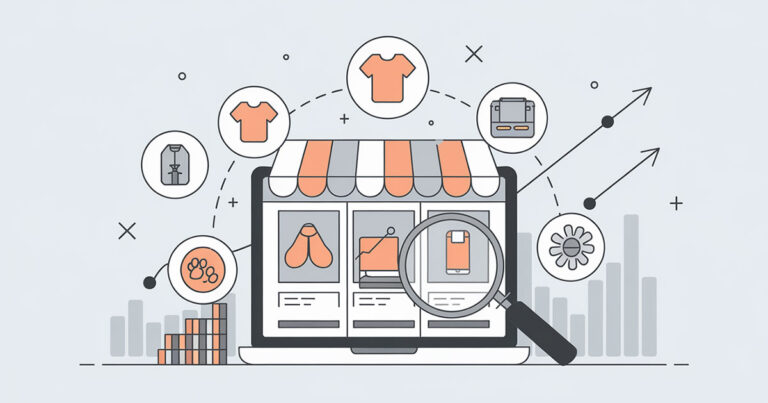The Disadvantages Of Dropshipping
The Disadvantages and Challenges Running a Dropshipping Store
Dropshipping is a great way to start an online business with minimal financial risk. With platforms like Shopify, you can be up and running within a few hours. However, despite the many advantages of dropshipping, there are some downsides. In this article, I will cover some of the most common disadvantages of dropshipping.
What is Dropshipping?
Dropshipping is an e-commerce fulfilment model where a store doesn’t keep the products it sells in stock. Instead, when a store sells a product, it purchases the item from a third party and has it shipped directly to the customer.
This means the seller doesn’t have to worry about storing inventory or shipping products, making it a great option for those wanting to start an online business without many upfront costs.
Benefits of Dropshipping
There are many benefits to using a dropshipping business model, which is covered fully in my article The advantages of dropshipping.
How to Get Started
If you’re not fully up to speed with how to get started with dropshipping, here’s a brief overview. A more detailed step-by-step setup can be found here.
To get started with dropshipping, follow these steps:
1. Choose a niche: Determine what type of products you want to sell and research potential suppliers.
2. Find a supplier: Find reliable suppliers offering quality products and fast shipping.
3. Build your online store: Set up a website or use an e-commerce platform like Shopify to create your online store.
4. Promote your store: Use digital marketing strategies like social media and email campaigns to attract customers.
5. Manage your orders: Once you start making sales, manage your orders and customer service to ensure a positive experience for your customers.
Dropshipping can be a great way to get started with e-commerce fast. However, it would help if you considered some downsides to dropshipping before diving in. Once you know the pitfalls of dropshipping and what to avoid, it will help you become successful on your dropshipping journey.
Shipping Disadvantages Of Dropshipping
Lack of Control Over Shipping and Packaging
Logistics companies are responsible for storing, picking, packing, and shipping the products you buy online. They have their own processes and systems for doing this, which can often differ from the seller’s methods.
As a result, you, as the seller, have little say in how your products are shipped and packaged.
For example, you ordered a book from an online bookstore. The bookstore has no control over how the supplier or shipping company will package the book. It could be wrapped in bubble wrap, placed in a padded envelope, or put in a cardboard box with packing peanuts. The seller only requires that the book arrives at your doorstep in good condition. If it doesn’t, they may have to issue a refund or send a replacement, which can be costly and time-consuming.
Shipping Delays
Another problem with relying on third-party logistics is that shipping delays can occur. This can be due to various reasons, such as weather, traffic, or mechanical problems. When this happens, the seller has no control over when the product will arrive at your doorstep. They can only apologize and hope that you’ll be patient. Often the choice of the shipping company is decided by the drop ship supplier at the cheapest rates.
Shipping delays can be frustrating for both the seller and the buyer. The seller may receive negative feedback or lose future business if the buyer is unhappy with the delay.
The buyer may become impatient and cancel the order or decide to shop elsewhere in the future.
Selling products online can be convenient and profitable. Still, it’s important to remember that the seller often has little control over the shipping and packaging process when using a dropshipping business model.
Dependence on Third-Party Fulfillment
Poor Quality Control
One of the biggest concerns with using third-party fulfilment is the potential for poor quality control. Since the fulfilment service is responsible for packaging and shipping the products, any mistakes or oversights they make can reflect poorly on the seller’s business. For example, suppose a customer receives a damaged or incorrect item. In that case, they may blame the seller rather than the fulfilment service.
Businesses should be very selective when choosing a fulfilment provider. They should research the provider’s reputation, ask for references, and consider using a provider with a proven track record of quality control. However, sometimes the choice of fulfilment provider is outside the seller’s power, and the seller is dependent on the dropshipping suppliers’ fulfilment options.
Returns and Refunds Become Complicated
Another challenge when running a dropshipping store is that returns and refunds can become complicated. If a customer needs to return an item, they will likely need to contact the seller for assistance. However, since the dropship supplier is responsible for storing and shipping the products, they must also be involved in the return process.
This can lead to confusion and delays, frustrating customers and damaging the sellers’ reputation.
While dropshipping can be a convenient solution for e-commerce businesses, it can also come with challenges.
Lower Product Margins
When it comes to dropshipping, one of the most important things to consider is the profit margin. Profit margin refers to the amount of money a business makes after deducting the cost of goods sold.
In dropshipping, profit margins can be lower due to several factors.
Lower Profit Margins Due to Dropshipping Fees
When a retailer engages in dropshipping, they are essentially outsourcing their logistics and shipping to a third-party supplier. This means that the retailer must pay a fee to their dropshipping supplier for each shipped item. These fees can vary depending on the supplier but can eat into the retailer’s profit margins.
Furthermore, because the retailer doesn’t handle the shipping themselves, they have less control over the shipping costs. If the dropshipping supplier’s shipping costs increase, the retailer’s profit margins decrease. This is an important factor to consider when choosing a dropshipping supplier.
Competition From Other Dropshipping Stores
Another factor that can decrease profit margins in dropshipping is competition. Because it’s relatively easy to set up a dropshipping business, there are a lot of other retailers out there competing for the same customers.
This competition can lower prices as each retailer tries to undercut the others. When prices are lower, profit margins are lower as well. This means that dropshipping retailers must be creative in finding ways to stand out from their competition and offer something unique to their customers.
Retailers must be aware of the fees associated with dropshipping and the competition they will face to make informed decisions about their pricing and profitability.
Poor Customer Service
As a consumer, nothing is more frustrating than experiencing poor customer service. Unfortunately, many people have to deal with this regularly, which can be incredibly discouraging. This section will discuss two common issues related to poor customer service with dropshipping: long response times and lack of customer transparency.
Long Response Times
Long response times are one of the customers’ most common complaints about companies. When someone reaches out to a company with a question or concern, they expect a timely response. Unfortunately, this is not always what happens. Some companies take days or even weeks to respond to customer inquiries, leaving their customers feeling frustrated and ignored.
With drop shipping, the seller is reliant on the dropshipping supplier for information regarding returns or replacements. Having 3-way conversations between the customer and supplier, the seller is in a tough position.
Lack of Transparency with Customers
Another issue is that many dropshipping suppliers don’t provide enough information regarding the terms, handling or processing times and other important factors to enable the smooth running of the drop ship process.
Sometimes the lack of transparency can be down to language and poor communication due to sourcing products from countries which speak a different language to the seller.
Lack of transparency can also manifest in not providing regular updates about an order or product status, leaving sellers in the dark. Or, they might not be honest about the reasons behind delays or issues, which can have knock-on effects on the buyer.
Difficulty in Building Brand Image
When building a successful brand, companies can often face various challenges that hinder their efforts to create a strong and recognizable identity.
Dependence on Supplier Branding
Another challenge that businesses face with dropshipping is the dependence on supplier branding. Supplier branding refers to relying on the brand image of the products or services that a company sources from its suppliers. This can be problematic because it does not allow companies to create a brand image.
For instance, a shoe retailer may rely heavily on the branding done by the shoe manufacturer rather than creating its own brand image. In doing so, the retailer becomes dependent on the manufacturer’s image and may be unable to establish a unique identity that resonates with its target customers.
As a retail seller, you should be wary of drop ship suppliers who insist on promoting their own brand on products.
Increased Dropshipping Competition
The world of e-commerce has exploded in recent years, and with it, the number of dropshipping stores has skyrocketed. This means that the market is getting crowded, and competition is increasing.
Crowded Market Competition
A crowded market is not necessarily bad, but it means you need to work harder to stand out. With so many options available to consumers, you need to ensure that your store is the one they choose. This means you need to focus on your branding, customer service, and unique selling point.
Dropshipping Stores All Look The Same!
One of the biggest challenges facing dropshipping stores is the inability to differentiate themselves from their competitors. It can be difficult to stand out with so many similar products and stores, so it’s important to focus on what makes your store unique.
Do you offer faster shipping times than your competitors? Have you got a wider range of products? What particular niche that you specialize in? These are all things that can help you to differentiate yourself from other dropshipping stores.
Ultimately, the key to success in a crowded market is to be innovative and creative. Think outside the box and find new ways to capture the attention of your target audience. With hard work and determination, you can build a successful dropshipping store that stands out from the crowd.
Inventory Management Challenges
When running a successful business, inventory management is a critical component. It’s important to understand business owners’ challenges when managing their inventory.
Dependence on Dropshipping Supplier Stock
One of the biggest challenges of inventory management is dependence on supplier stock. In other words, businesses rely on their suppliers to provide them with the products they need to sell. If a supplier runs out of stock, it can be challenging for a business to fulfil its customer’s orders. This can lead to lost sales, dissatisfied customers, and even reputational damage.
One of the sellers’ best-selling may be out of stock. Still, that product is unimportant for the drop ship supplier and is a small part of the overall supply chain. It can mean big losses to the seller due to the suppliers’ poor stock management.
Conclusion
A. Recap of the Disadvantages of Dropshipping
In this article, we have explored the world of dropshipping and discussed the various disadvantages that come with it. Some of these disadvantages include the following:
1. Limited Control: As a dropshipper, you have limited control over the products you sell, the quality of those products, and the shipping process. This can lead to customer dissatisfaction and negative reviews.
2. Low Margins: Due to the increased competition and the need to keep prices low, dropshippers often have low-profit margins, making it difficult to sustain their business.
3. Supplier Issues: Partnering with unreliable suppliers who fail to deliver products on time can result in lost sales and a damaged reputation.
Overcoming The Disadvantages Of Dropshipping
While the disadvantages of dropshipping cannot be ignored, there are ways to overcome these challenges and build a successful business. Here are some suggestions:
1. Research and Select Reliable Suppliers: Investing time and effort in researching and selecting reliable suppliers who can provide quality products and timely shipping is essential.
2. Build a Strong Brand: By building a strong brand, dropshippers can differentiate themselves from competitors and establish a loyal customer base.
3. Focus on Niche Products: Dropshippers can focus on niche products and target a specific audience instead of selling everything.
4. Offer Excellent Customer Service: Providing excellent customer service can help dropshippers build a positive reputation and retain customers.
In summary, while drop shipping may have challenges, there are ways to overcome them and build a successful business. By focusing on quality suppliers, building a strong brand, targeting niche products, and providing excellent customer service, dropshippers can thrive in the competitive e-commerce industry.






